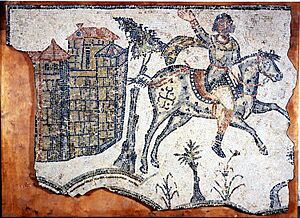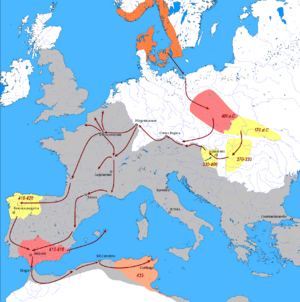Capture of Carthage (439) facts for kids
Quick facts for kids Capture of Carthage |
|||||||
|---|---|---|---|---|---|---|---|
| Part of Vandalic conquest of Roman Africa | |||||||
 Vandal cavalryman, c. AD 500, from a mosaic pavement at Bordj Djedid near Carthage |
|||||||
|
|||||||
| Belligerents | |||||||
| Vandals | |||||||
| Commanders and leaders | |||||||
| Genseric | Unknown | ||||||
| Strength | |||||||
| Unknown | Unknown | ||||||
| Casualties and losses | |||||||
| Unknown | Unknown | ||||||
Imagine a powerful city, Carthage, being taken over! This happened on October 19, 439. The Vandals, led by their strong king, Genseric, captured Carthage from the Western Roman Empire.
The Vandals had already crossed the Strait of Gibraltar into Africa. In August 431, they captured Hippo Regius. This city became the first capital of their new kingdom. Even though they had a shaky peace with the Romans, Genseric launched a surprise attack on Carthage. After taking the city, the Vandals made Carthage their new capital.
Contents
The Vandals' Journey to Africa
Starting in Gaul
The Vandals were a group of people who moved across Europe. In 406, they traveled west along the Danube River. When they reached the Rhine River, they faced the Franks. The Franks controlled parts of northern Gaul.
A big battle happened where many Vandals died, including their leader, Godigisel. But with help from the Alans, they defeated the Franks. On December 31, 406, the Vandals crossed the Rhine River. They then moved into Gaul, causing a lot of damage. Under Godigisel's son, Gunderic, the Vandals continued to move west and south through Aquitaine.
Moving to Spain
In 409, Gunderic led the Vandals across the Pyrenees mountains. They settled in Spain in two main groups. One group, the Asdingi, lived in Galicia. The other group, the Silingi, settled in Andalusia.
For the next twenty years, the Vandals fought many battles. They fought against the Roman armies and other groups like the Goths and the Suevi. The Silingian Vandals were almost wiped out. But the remaining Alans, who were from Iran, joined them. They marched across Spain and took over Andalusia.
Crossing to Africa
After Gunderic died in 428, his half-brother, Genseric, became the new leader. In May 428, Genseric gathered about 80,000 Vandals on the southern coast of Andalusia. They sailed to Africa later that year. Some say they were invited by Bonifacius, a Roman general in Africa. He had problems with the Roman government.
After crossing near Tingis, Bonifacius asked the Vandals to leave Africa. But Genseric refused. Bonifacius led a mixed army of Romans and Goths. But Genseric defeated him near the town of Calama. Bonifacius and his remaining soldiers went to the city of Hippo Regius. Genseric then quickly took over many areas. By May 430, only three Roman cities in Africa were left: Carthage, Hippo, and Cirta.
The Capture of Carthage
The siege of Hippo Regius lasted from May 430 to July 431. The Vandals could not capture Hippo. So, a peace treaty was made on January 30, 435. This treaty was between the Roman emperor Valentinian III and Genseric. The emperor kept Carthage and its rich area. Hippo and six other African regions were given to the Vandals.
Genseric followed this treaty only as long as it helped him. On October 19, 439, he suddenly attacked Carthage. He did this without warning. The Vandals took the city. This important city, one of the biggest in the Roman Empire, was under Vandal control for 94 years.
Genseric spent most of his later life in wars. But he was more interested in taking valuable things than in conquering land. He turned Carthage into a base for pirates. He attacked places he believed "God was angry" with.
Genseric created a strong Vandal fleet, which was rare for a barbarian group. For 30 years, he was the most powerful naval leader in the Mediterranean Sea. His most famous raid was the sack of Rome in 455. He did this after being asked by Licinia Eudoxia, the emperor's widow. He took Rome easily. For 14 days, he calmly took all the valuable items from the city. It is said that sacred items from the Second Jewish Temple, brought to Rome by Titus, were taken to Carthage. Eudoxia and her two daughters were also taken captive. One daughter, Eudocia, married Hunneric, Genseric's oldest son. Eudoxia and her other daughter were later sent to Constantinople after long talks.
Images for kids







